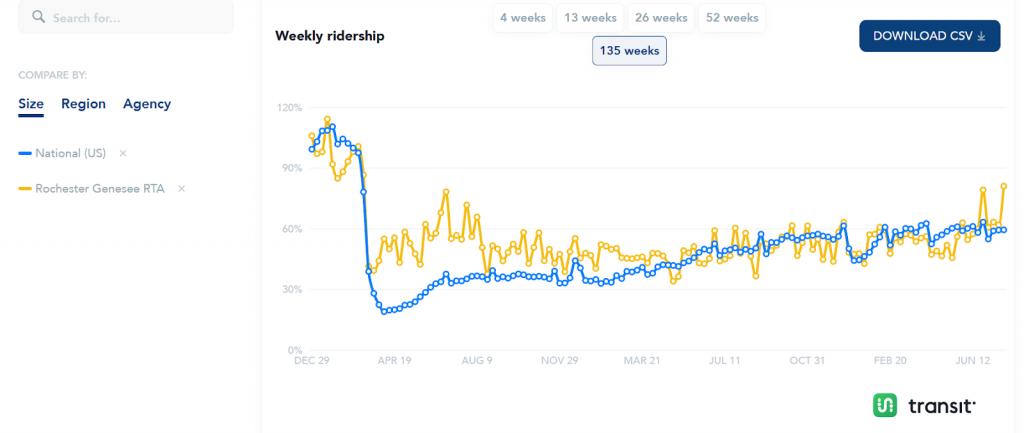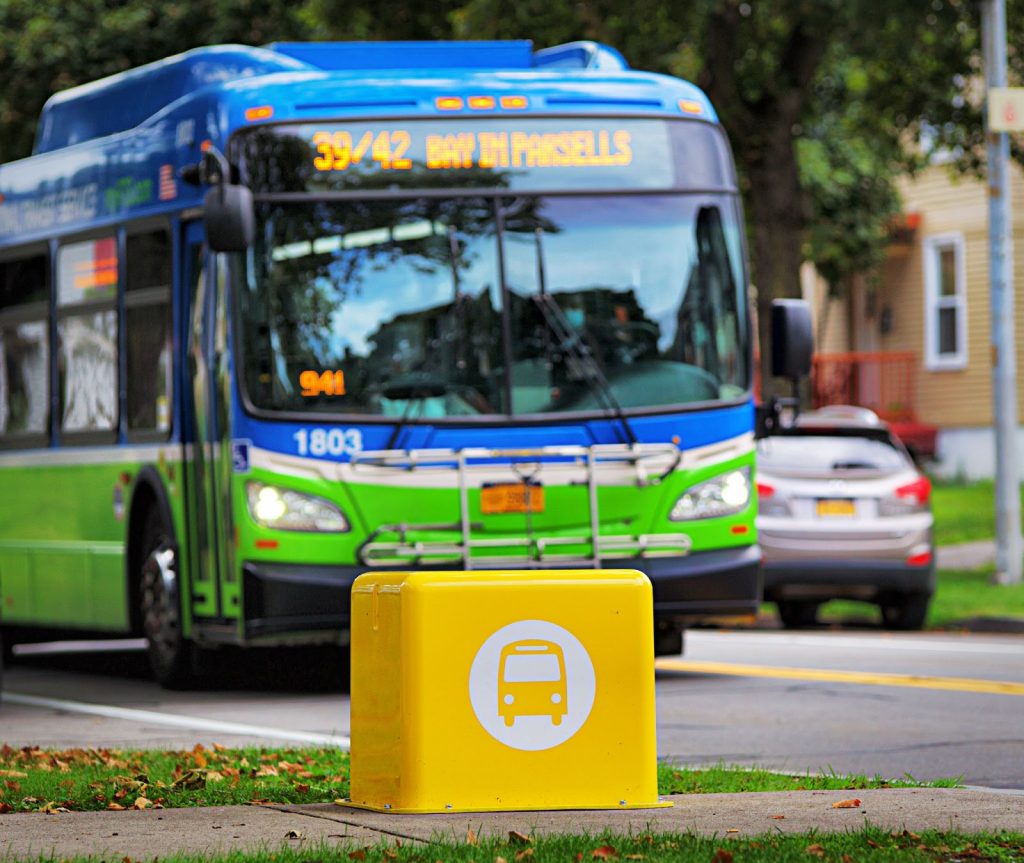Reconnect Rochester meets with the team at RTS on a regular basis. We listen and ask questions. We share feedback from transit riders and offer ideas. We seek to understand and strive to be a good community partner.
Many of you might be wondering what’s going on with all the service changes over the last few years. We want to share our latest understanding with the general riding public, and anyone else who cares about having reliable public transportation in our community. Read on for our take on what happened, what’s happening, and what to expect.
As an advocacy organization, it’s important for us to collect input and channel it to the ears of RTS leadership so they can better understand the impact of their decisions on transit users. To that end, we’ve constructed a survey to find out from RTS riders how your experience has changed (for better or worse) since the implementation of the Reimagine RTS system redesign last spring. We also want to hear from former RTS riders about why you have stopped riding and what it would take to get you back.
We’ll be collecting this input through the month of August online and in-person, and then we’ll collate it and pass it on to RTS leadership. Please help us out by sharing this survey with your friends!
_______________________
What’s the current situation and what can we expect?
We’ll give it to you straight first with no sugar added, and then add a dash of hope and sweetness later.
RTS ridership is still hovering around 65-70% of pre-pandemic levels with no sign of an upturn.
On-demand service in the mobility zones is exceeding demand, resulting in a service denial rate of 30-35%. The service management platform has been problematic. This combination has made service in the towns and suburbs of Monroe County often frustrating and unreliable.
Five (5) of the seven (7) 15-minute frequency routes in the core service area – the big promise of the Reimagine RTS system redesign – reverted back to 30-minute frequency. The result is worse service for some riders than they had before.
RTS doesn’t expect any of this to change or improve until at least January 2023, when new buses and vans arrive, enough drivers are hired, and a new on-demand technology platform is put in place.
Who is impacted most?
The unfulfilled promise of Reimagine RTS of more frequent and robust service is a burden that falls squarely on transit dependent people in our community. It stands to reason that transit dependent folks make up most of the 70% of riders who are still on the bus. Unlike “choice riders” who were able to choose another way to get around, this group of folks don’t have another option than to rely on the bus.
With the system as it is, a commute time that was already long, is made longer. Those who live or need to get to work in the mobility zones are especially hard hit. Because demand is far outpacing service capacity, there is a new unreliability that is arguably worse than the service that existed before. At least then you knew a fixed route bus would be coming along at a set time, even if only every 60 minutes.
How did we get here?
The pandemic took a huge toll on RTS. In June 2020, the long-awaited Reimagine RTS system redesign launch was postponed as RTS focused on pandemic response, health safety on buses, and pitching in to meet emergency transportation needs. Reimagine RTS finally launched almost a year later in May 2021.
A few months later (Sept 2021), a shortage of private contract bus drivers created a crisis with RCSD school bus transportation. RTS stepped in and provided service so that kids could get to school. However, to free up buses and drivers, they rolled back the 15-minute frequent service that had been the hallmark of Reimagine RTS.
For the last year, RTS has been struggling to get the buses and drivers in place so they can add back the frequency in regular service and meet the unexpectedly high demand for on-demand service in the mobility zones. The good folks at RTS want to restore the frequent service as much as anyone and are working overtime to problem-solve the situation.
There are two things standing in the way: 1) Supply chain issues have prevented vans and buses, ordered more than a year ago, from arriving. 2) Steep competition in the labor market has made it more challenging to hire RTS drivers. In April 2022, due to ongoing equipment and staffing shortages, RTS announced service changes that included “pausing” the new Rt 42 crosstown, another rollback of the Reimagine RTS system redesign.
It’s little comfort, but we are not alone in this. Transit ridership is down everywhere in the wake of the pandemic. Equipment and bus driver shortages are plaguing transit systems across the country, and have led to even more severe service cuts in neighboring Buffalo and Syracuse over the past year.

Is there any good news?
Yes, there is plenty.
A host of Reimagine RTS service improvements were successfully implemented and have made a big difference for many riders. Things like increased weekend service hours and frequency, the Rt 40 & 41 crosstown routes, newly added 30-minute frequency routes, and two 15-minute frequency routes (E. Main & Dewey Ave) that were reinstated.
This spring, the RGRTA Board approved a new service management platform in the mobility zones to replace the problematic one, so that fix is on its way.
Ridership data collected from the 15-minute routes has proved beyond a shadow of a doubt that frequency = increased ridership. Unexpectedly high ridership in the mobility zones shows there’s a strong demand for public transit in the towns and suburbs. What’s the takeaway? When we can restore the promises of Reimagine RTS, we will see huge gains in ridership.
Thanks to advocacy efforts led statewide by NYPTA and locally by Reconnect Rochester, as well as our Albany delegation’s support for public transportation, State Transit Operating Assistance funding for RGRTA will be increased by 15.17%. This removes funding as a barrier to service expansion & restoration (the problem is that money can’t solve the immediate problem of staffing and equipment shortages).
Many would say the Transit App has been a bright spot. Anyone who uses it can attest to the awesome design and functionality to guide transit riders in moving around.
RTS is leading New York State in the conversion to electric buses and also just got State funding to add hydrogen fuel cell buses to its fleet in the coming years. That’s a great thing for the environment and the quality of the air we breathe.
Finally, there’s also hope for expansion of bus amenities to improve the riding experience. Reconnect Rochester just got 23 more bus stop cubes on the ground, bringing the total to 54 bus stops around the city. Even more exciting, the City of Rochester with support from RTS, is applying for a $2M State funding grant to make a sweeping investment in bus stop amenities. This could mean shelters, benches, and bus stop cubes installed at hundreds of stops in the city that currently have no seating. Keep your fingers and toes crossed!
What can RTS do?
We wouldn’t be a very worthwhile advocacy organization if we didn’t point out some ways that RTS can do better even under the current constraints.
We challenge RTS to acknowledge what its customers are really experiencing minus any positive spin. Be transparent and communicate what’s happening. As transit riders, we’d like to know what’s going on. Share ridership statistics and denial rates with the community and explain why. Tell us what you’re doing to resolve the service issues. How many drivers are in the pipeline? How many buses are on order? What’s the timeline for the new user management system for the mobility zones? You get the idea.
What can we/YOU do?
Fill out our survey to share your experience.
Whether you’re a current rider or a former rider that has stopped riding the bus, we want to hear from you. We promise to deliver your thoughts to RTS leadership in the hope that your voice will impact future decision making.
If you ride RTS regularly, keep sending them your feedback.
They might not be able to make major changes happen, but they have been responsive to small improvements when they hear a sensible adjustment that can be made. Positive feedback is important, too. If RTS does something that improves your situation, let them know! Also, driving a bus can be a difficult and stressful job. A friendly greeting to the driver when you enter the bus, and thanking them for getting you to your destination safely can make a difference. You can play a part in driver retention!
Ditch the car and ride RTS whenever it works for your schedule.
Mary at Reconnect talking here. My own personal commute improved significantly thanks to the new Route 41 crosstown, which gets me to the office in 17 minutes door-to-door. In those 17 minutes, I get to enjoy some fresh air and a little exercise, check my inbox, give and take smiles (even if only with the eyes) with fellow passengers, and save gas money leaving the car at home.
Wondering what your bus commute would look like? Visit myrts.com or download the Transit App to find out!
We still believe
Reconnect Rochester has long advocated for a public transit system that delivers frequency. We still believe that the Reimagine RTS plan – when fully implemented – will set us on a path to a more frequent and robust system. There are tradeoffs, yes, but it will be a net positive overall.
At Reconnect Rochester, we look forward to when we will see the full promise of the new system fulfilled, and can truly welcome in a new day for public transportation in Rochester. We look forward to bringing back our Roc Transit Day event to showcase the changes and attract busloads of new choice riders – because choice ridership enriches the whole system, making it better for everyone. We look forward to the day when public transportation can serve as an integrating, rather than segregating, force in our community.




